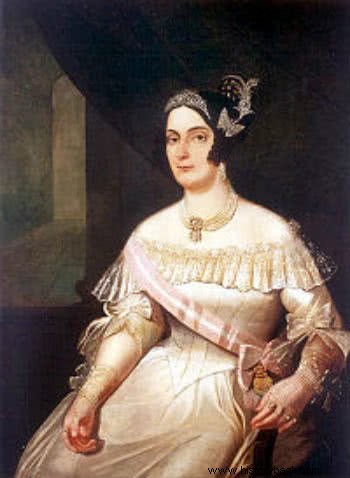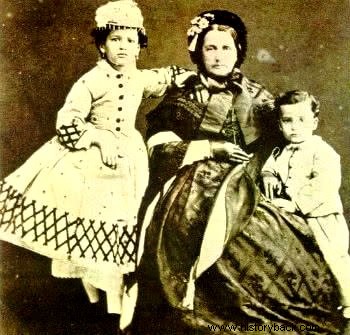Domitila de Castro Canto e Mello, the Marquesa de Santos , was the best known mistress of Emperor Dom Pedro I.

Marquesa de Santos portrayed with the sash of the Order of Saint Isabel.
Biography
Domitila de Castro Canto e Mello was born in São Paulo, in 1797, in the middle of one of the most traditional families in the city.
As was common at that time, she got married at age 15 to Lieutenant Felício Pinto Coelho de Mendonça and they moved to Vila Rica / MG, where her husband's regiment was located. This one turned out to be a violent man who beat his wife.
Contrary to social conventions, Domitila returns to her father's house with her two children and asks her husband for a divorce. The couple would still try to reconcile in 1818, but after suffering an assassination attempt on the part of her husband, Domitila abandons him and retires to her grandmother's house.
On August 29, 1822, while visiting important families in São Paulo, Dom Pedro met Domitila. A few days later, he would proclaim the separation of Portugal and Brazil, but he would not forget it. In a matter of months, Domitila would be installed in Rio de Janeiro and their romance would last five years.
Discover the life of Dom Pedro I.
Influence in the Brazilian Court
Dom Pedro I did not hide his preference for the paulistana and, thus, bought and had a house renovated for his mistress near the palace of São Cristóvão. Currently, it houses the Museum of the First Reign.
With the consolidation of imperial power, Domitila was able to attract into her house the discontented with José Bonifácio and his brothers, who wanted to limit the Emperor's power in the Constitution of 1824.
During the time she lived with Dom Pedro I, both Domitila and her family were awarded titles of nobility and nobility.
In 1825, she was appointed lady-chamber of the Empress D. Leopoldina (which meant that both met daily), made Viscountess of Santos with grandeur and a year later, she would obtain the title with which she would go down in history:Marquesa de Santos.
In turn, her parents would become Viscounts of Castro and her sister and her husband would become barons of Sorocaba. Installed in a mansion in the neighborhood of Botafogo, there Dom Pedro I would maintain romantic encounters with Domitila and also with his sister. The baroness of Sorocaba even had a son with the sovereign who was recognized in her will. Revolted, Domitila planned the murder of her own sister, but failed in the attempt to kill her.
Dom Pedro I's behavior scandalized Brazilians and European courts. The death of the Empress Dona Leopoldina, in 1826, would serve to reinforce her unpopularity. There were even those who accused Domitila of having killed the sovereign by poisoning, but these are baseless suspicions.
Despite his affection for the Marquise de Santos, Dom Pedro I was quite pragmatic about his second marriage. He started looking for a wife of noble blood after the death of Dona Leopoldina. The chosen young princess, Amelia of Leuchtenberg, demanded that the marquise and children be expelled from the court before the marriage could take place.
Learn more about the First Reign.
Life after the break with Dom Pedro I
Domitila's romance with Dom Pedro I produced five children, two of whom reached adulthood:
- Isabel Maria de Alcântara Brasileira, Duchess of Goiás;
- Maria Isabel II of Alcântara Bourbon, Countess Consort of Iguaçu.
The first would go to Europe when Dom Pedro I abdicated the Brazilian throne and the second would remain with the Marquise de Santos.
Again, contrary to the conventions of the time, in 1833, Domitila joined Brigadier Rafael Tobias Aguiar, with whom she would have six children. Tobias Aguiar was a farmer and politician from São Paulo, having been twice president of the province of São Paulo. Only in 1842 would the couple be formally married.
Installed in a beautiful manor house located at Rua do Carmo, the Marquise rebuilt her social life, offering balls and soirees much appreciated by São Paulo society.
Tobias Aguiar would become involved in the Liberal Revolt of 1842 and would be imprisoned in Fortaleza de Lage, in Rio de Janeiro. The Marquise de Santos went to the capital of the court to ask Emperor Dom Pedro II for permission to take care of her husband in prison, as he was sick. This gesture moved the young sovereign who granted him permission.
Death

Marquesa de Santos with her grandchildren.
Tobias de Aguiar would die in 1857, leaving Domitila a widow with five children already in adulthood.
The Marquise de Santos dedicated the remaining ten years of her life to charity work, financially helping students at the São Paulo Law School and visiting the sick. She was also noted for defending liberal ideas and participating in São Paulo's electoral campaigns.
She died on November 3, 1867, in São Paulo, at the age of 70. She is buried in Consolação Cemetery, next to her daughter, the Countess of Iguaçu.
The manor house where the marquise lived now houses the Museum of the City of São Paulo.
Films and Documentaries
- Independence or Death. Directed by:Carlos Coimbra.1972
- Marquise de Santos. Directed by:Ary Coslov.1984.
- Marquesa de Santos - a true story. Directed by Dimas Oliveira Junior and Luis Felipe Harazin. 2002.
